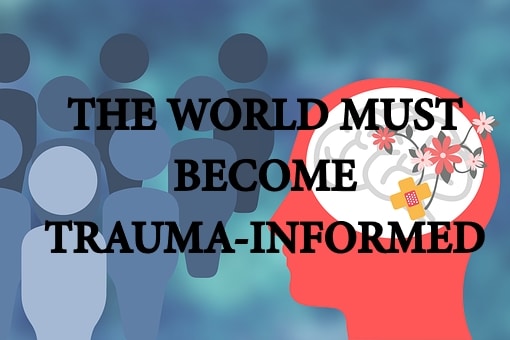Many people are ill-informed or know nothing about mental health disorders, including complex post-traumatic stress disorder (CPTSD) and how it affects those around them. There are hundreds if not thousands of mental health challenges, and unfortunately, the stigma surrounds them.
This article will explore trauma and how the public and medical professionals must learn more so that informed actions can be taken.
The Stigma That Holds Us Back

Early in the 18th century, people living with a brain disorder such as a reaction to trauma were shut away in their family home in a secluded bedroom, prison, or an almshouse. The treatment they received was inferior, with the main two being bloodletting or substances to cause vomiting. People didn’t try to understand the trauma-formed mental health disorder their loved ones had; they just hid them away and treated them as outcasts.
That stigma (discrimination) against people with trauma didn’t end with the 19th century, as in the 1920s and 1930s, the use of asylums increased as more were built. The problem with these asylums is that they lacked hygiene, were overcrowded, and were places of abuse of patients. There was no actual treatment for trauma.
Today, in the 21st century, things have improved for the traumatized with the dawn of new medications and treatments, but people still do not understand the complicated sphere of trauma-induced mental health problems. This lack of understanding and unwillingness to examine how people living with trauma challenges should be treated led to discrimination.
Trauma and Trauma-Informed Care
Most people have heard the word trauma but are clueless about what the word means. Trauma is an emotional response to a stunning event such as rape, natural disaster, or the sudden death of a loved one. Soon after the event ends, shock and denial set in. However, longer-term reactions include flashbacks, unpredictable emotions, and problems with intimate relationships.
Trauma-informed care is a method of thinking and interventions engaged by learning about the serious neurological, psychological, biological, and social effects trauma has on the traumatized.
Recognizing that someone has been traumatized and then treating them for the terror they still feel inside is critical to helping them heal. Medical professionals must recognize the traumatized needs for connection and safety and offer methods to manage emotions and impulses.
The Importance of Truthful Information for Physicians

The world is awakening slowly to the importance of understanding what trauma is and how to treat it. Becoming trauma-informed is vital for the public and those who treat them because many do not understand trauma.
While there is a lot of research and literature available, we must make sure there is much more truthful information made available. Those who treat mental health patients need not be in the dark or treat those who live with mental health issues, like complex post-traumatic stress disorder, differently than anyone else.
What is Trauma-Informed Approach?
People who become trauma-informed learn about how trauma alters the lives of those who have experienced it. A trauma-informed therapist or another licensed caregiver can recognize through proper training and trauma-informed reading material how to be helpful to their clients and not harmful.
In the United States, there is a federal organization called Substance Abuse and Mental Health Services Administration (SAMHSA). They have this to say about trauma and its effects on adults and children.
“Trauma has no boundaries regarding age, gender, socioeconomic status, race, ethnicity, or sexual orientation. Trauma is a common experience for adults and children in American communities, and it is especially common in the lives of people with mental and substance use disorders. For this reason, the need to address trauma is increasingly seen as an important part of effective behavioral health care and an integral part of the healing and recovery process.”
But what does trauma-informed mean, and how can a licensed professional learn about the trauma-informed approach? Here again, we can turn to SAMHSA.
On another page on their website, SAMHSA outlines the four principles of the trauma-informed approach for therapists to follow.
- The therapist must realize the widespread impact of trauma and understand potential roads to recovery.
- The therapist recognizes the signs and symptoms of trauma in their clients and their families, plus staff and other people engaged in the mental health system.
- The therapist responds to traumatized individuals by fully integrating knowledge about trauma policies, procedures, and practices.
- The therapist will attempt to resist re-traumatizing their client.
By following the trauma-informed approach, therapists can create the right treatment plan for their clients looking for their help.
The Six Trauma-Informed Approach Key Principles

The trauma-informed approach is a how-to aligned with healing-informed care.
By providing and supporting their clients through the trauma-informed approach, therapists, doctors, and other medical professionals boost their patient’s healing power.
In the booklet Trauma-Informed Care in Behavioral Health Services, SAMSHA gives an excellent description of the key principles of the trauma-informed approach.
These fundamental principles involve safety, trustworthiness, peer support, collaboration and mutuality, empowerment, and cultural, historical, and gender issues. By offering these key principles in their treatment of their clients, professionals are collaborating with them and opening new doors to healing. I will explain the fundamental principles better in another piece.
Coming Out of the Dark
While trauma and trauma-informed care were neglected in the past, today, a new day is dawning. Many physicians, psychiatrists, psychologists, and other medical community members are waking up to the reality that the problems they see in their offices are often caused by trauma.
We are beginning to learn the depth of the problem of trauma and how we can treat it to give people a fighting chance of recovery. Trauma-informed doesn’t just mean knowing what trauma is, and that it causes great harm, but also finding new treatment methods.
The public must also be taught about trauma and how it affects their lives. They must realize the symptoms and mental health disorders we know to accompany trauma.
Only through the spread of copious amounts of literature and other forms of communication can we hope to spread the word about trauma. We must teach them so that they can move forward with their lives, having conquered trauma.
Ending Our Time Together
Trauma is an emotional response to horrific events, such as the sudden loss of a loved one or a natural disaster. It is accompanied by shock, denial, flashbacks, and problems with intimate relationships. It is predicted that 70% of adults in the United States (223.4 million) have experienced some type of trauma at least once in their lives. There is a massive problem with trauma, and using a trauma approach may help.
This first article in the new series on trauma-informed care and the need for more literature on the subject has concentrated on introducing the topic to the reader. In the next two posts, we shall examine how people need to learn about trauma and methods to help them do just that.
The ultimate value of life depends upon awareness and the power of contemplation rather than upon mere survival. – Aristotle
Resilience is all about being able to overcome the unexpected. Sustainability is about survival. The goal of resilience is to thrive. – Jamais Cascio

My name is Shirley Davis and I am a freelance writer with over 40-years- experience writing short stories and poetry. Living as I do among the corn and bean fields of Illinois (USA), working from home using the Internet has become the best way to communicate with the world. My interests are wide and varied. I love any kind of science and read several research papers per week to satisfy my curiosity. I have earned an Associate Degree in Psychology and enjoy writing books on the subjects that most interest me.





Though it may be clinically labelled as some other disorder, I have a self-diagnosed condition involving ACE trauma, ASD and high sensitivity — which I freely refer to as a perfect storm of train wrecks. It’s one with which I greatly struggle(d) while unaware, until I was a half-century old, that its component dysfunctions had official names.
Thus, I believe it would be helpful to have a book written about such conditions involving a tumultuous combination of high sensitivity, adverse childhood experience trauma and/or autism spectrum disorder (the latter which, I’ve found, has some symptoms similar to high sensitivity).
I read a book about highly sensitive men that totally fails to even mention the real potential for additional challenges created by high sensitivity combining with adverse childhood experience trauma and/or an autism spectrum disorder. Similarly, The Autistic Brain completely excludes any mention of ASD coexisting with high sensitivity and/or ACE trauma, let alone the possible complications thus additional suffering created by such coexistence. And the book Childhood Disrupted, however informative, doesn’t even hint at the potential for having to suffer ACE trauma alongside ASD and/or high sensitivity.
I therefore don’t know whether my additional, coexisting conditions will render the information and/or assigned exercises from each of the three books useless, or close to it, in my efforts to live much less miserably. While many/most people in my shoes would work with the books nonetheless, I cannot; I simply need to know if I’m wasting my time and, most importantly, mental efforts.
Such a book, or books, could also include the concept of high school curriculum that teaches the science of the basics of young children’s developing brains and therefore healthy/unhealthy methods of parental/guardian rearing of children who are highly sensitive.
(In 2017, when I asked a teachers federation official over the phone whether there is any such curriculum taught in any of B.C.’s school districts, he immediately replied there is not. When I asked the reason for its absence and whether it may be due to the subject matter being too controversial, he replied with a simple “Yes”. This strongly suggests there are philosophical thus political obstacles to teaching students such crucial life skills as nourishingly parenting one’s child’s developing mind.)
I agree, it’s so important that not only therapists, but also other professionals are educated about trauma and the potential for retraumatisation. It’s particularly common to hear of clients retraumatised by other therapists who didn’t get it or doctors who didn’t understand their trauma responses or who acted in ways that clients found triggering.
Well done, Ms. Shirley. I totally agree we need more of this.